Machi Koro: Bright Lights, Big City adds a lot more variety to an already fun game
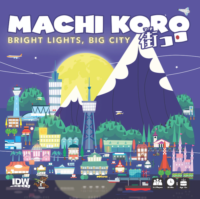
Normally when you see an existing game name followed by additional title words you think it’s an expansion to the original game. However in this case, the game is a re-implementation of the original game.
Machi Koro is a family card and dice game where players compete to build their cities to become the largest in the region. Players do this by rolling dice, collecting money, buying Establishments, and building Landmarks in their city. The first player to complete all of their Landmarks wins the game.
The exact same thing can be said for Machi Koro: Bright Lights, Big City.
So why do we like this new game so much more?
We’re happy to tell you why.
How to play Machi Koro: Bright Lights, Big City
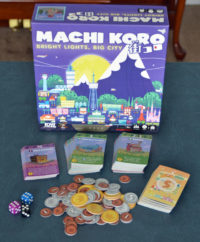
If you’re already familiar with Machi Koro, this part of our review will sound very familiar because the basic game play is the same.
However, there are a number of differences that really make the Machi Koro: Bright Lights, Big City more engaging than the original.
The first big difference is noticed in the game set up. Instead of starting with the same marketplace of 15 different Establishments card sets, players set up 3 rows that include a random variety of Establishments.
There are 3 decks of cards that each get their own row set out to form the Marketplace. The first deck is made up of cards that are numbered 6 or lower. The next deck is for cards numbered 7 or above. The last deck is the Purple cards.
Each deck is shuffled separately and then cards are drawn to create 3 rows of cards. The first two decks have cards drawn and placed face up showing 5 unique types of Establishments. If an Establishment card of a type that’s already showing is drawn, it’s simply stacked on top of those already out.
The third row of cards is drawn from the purple deck and only 2 unique face up Establishments are made available.
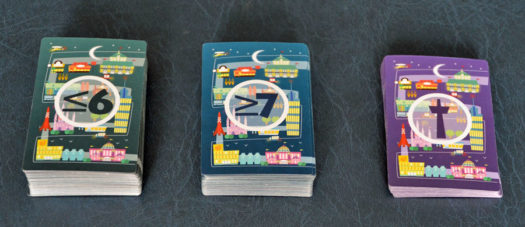
This simple change to the cards and the Marketplace makes a big difference in the variability (and subsequent fun) of the game.
Each player begins the game with 3 coins and 3 Establishments: a Wheat Field, a Bakery, and a City Hall landmark. They also receive cards representing their 6 Landmarks. They place their Landmarks facedown to represent “Under Construction” and they’re ready to go.
On a player’s turn, they’ll do 3 things:
- Roll
- Earn Income
- Construction
1. ROLL
The first thing a player does on their turn is roll the dice. At the start of the game, they’ll only be able to roll 1 die. Later, players will have opportunities to roll more dice (2 dice once they build their Train Station and 3 dice after they have a Moon Tower).
2. EARN INCOME
Based on the result of the die/dice roll, players will earn income. It’s also possible to earn income on another player’s turn.
To determine the income generated, players look at the resulting number on the dice rolled and compare it to the number at the top of their establishments.
For example, if a “2” or “3” is rolled, then a player’s starting Bakery goes to work. Each Bakery the current player has in their city will earn them 1 coin.
Establishments come in 4 different types. Each type earns income in different ways.
- Blue – Get income from the bank, during anyone’s turn.
- Green – Get income from the bank, during their turn only.
- Red – Take coins from the person who rolled the die.
- Purple – Get income from all players, during their turn only.
For example, if a 1 is rolled by any player, then all Wheat Fields (blue card) are activated. Regardless of who rolled the 1, every Wheat Field will generate 1 coin for the owner.
If a player has more than one type of an establishment in their city, the effects are multiplied. For example, if a player has 3 Bakeries in their city, they’ll earn 3 coins when they roll a 2 or 3.
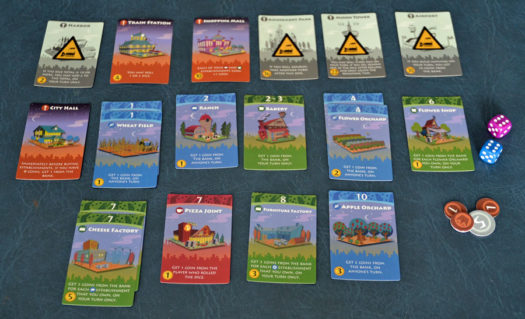
3. CONSTRUCTION
After earning income, the current player can pay to construct one building from the market or one of their Landmarks.
The cost of each Establishment or Landmark is located in the bottom-left corner of the card.
After paying coins to the bank, the player takes the purchased card from the central marketplace and adds it to their growing city. If they pay for one of their Landmark cards, they simply turn it over to the colored side and can begin using the associated benefit.
Players can have multiple types of each establishment except for those with a tower symbol (purple cards and landmarks).
Once they’ve constructed an Establishment or Landmark (or elected not to), their turn is over and play continues to the next player.
The game ends as soon as one player completes the purchase of their 6th Landmark. That player wins the game!
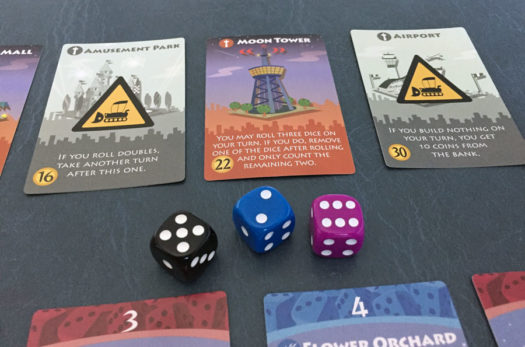
Can the whole family enjoy playing Machi Koro: Bright Lights, Big City?
Just like the original, Machi Koro: Bright Lights, Big City is a game everyone in the family can enjoy playing together.
The rules are very simple to understand and turns are rather quick – roll, get money, buy a card.
Once your kids can recognize written numbers, they can enjoy playing. And even though there’s text on every card, the colored cards and iconography are so memorable kids don’t have to know how to read to enjoy playing.
That being said, players who can develop a bit of a strategy will do better at the game.
I know that sounds funny to say about a game that’s very dependent of the roll of the dice. But strategy does have a part to play in the game.
By having options in which establishments to construct, the choices each player makes will definitely affect the outcome of the game.
Do you spend your money as soon as you get it? Or do you save up to buy something bigger?
When is the right time to start completing Landmarks and which ones do you complete first? They all give benefits, but they hice will help you more now vs later?
Do you want to just earn money from your own rolls (buy green and purple) or the rolls of other players (buy blue and red)?
Machi Koro: Bright Lights, Big City hits the sweet spot in the family board game market with its balance of fun, lucky dice rolling odds with a bit of light strategy.
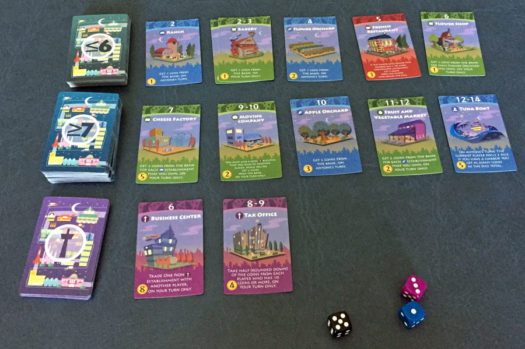
Why do we like Machi Koro: Bright Lights, Big City more than the original?
One of the issues we heard about the original Machi Koro is that players would develop an optimal strategy buying the same cards in the same order every time. So every game would play out close to the same – and the enjoyment would drop.
That’s why changing the Marketplace of which Establishments are available throughout the game is such a big deal. Now players must change up their approach every game depending on what comes up. That variability makes for a more satisfying experience all around.
Of course, the randomization of which Establishments are available and when also means some players may get a chance to buy certain cards and others not.
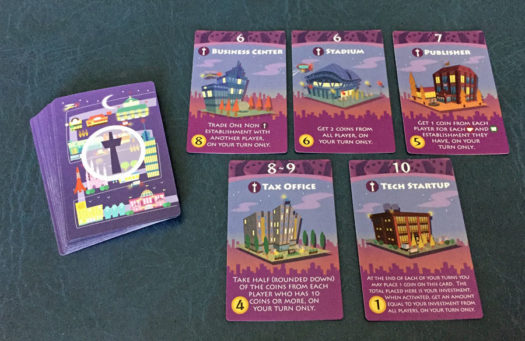
Rather than be put off by such a “lack of fairness”, we find that aspect more intriguing. My opponent may have a couple Ranches when I haven’t even had a chance to buy one. All that means is that I’ll have to adjust to a different path to getting ahead – maybe with Flower Orchards and Flower Shops or going after red cards to get money from them.
In addition the variability we also love a lot of the new cards in the game and the combos players can create. Well, maybe they aren’t completely new to you if you’ve already bought the Machi Koro Harbor and Millionaire’s Row expansions. But we didn’t pick up those expansions. So all of those cards (like the Flower Orchard, Mackerel Boat, French Restaurant, Sushi Bar, Pizza Joint, Soda Bottling Plant, Demolition Company, Tax Office, and more) are new to us and add a lot of variety.
One word of warning though is that the game takes longer than the 30 minutes indicated on the box. That’s the same amount of time listed for the original game. But with the variety of cards as well as the need to get 6 Landmarks constructed, the game will last longer. So it’s a good thing we’re having fun all along the way!
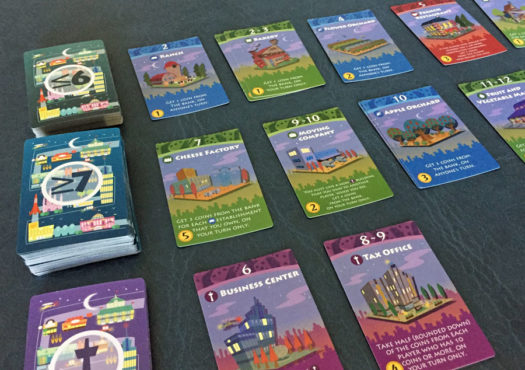
How does Machi Koro: Bright Lights, Big City score on our “Let’s Play Again” game meter?
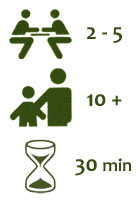 As you might guess, Machi Koro: Bright Lights, Big City gets a higher score on our “let’s play again” game meter than the original. A big reason for that is due to the variability in the game.
As you might guess, Machi Koro: Bright Lights, Big City gets a higher score on our “let’s play again” game meter than the original. A big reason for that is due to the variability in the game.
Every time we’ve played we’ve each tried different routes to victory. Not all of them have been successful, but they’ve been fun to try. And more importantly, every win has come from a different path to victory.
If you’re looking for a light family dice-rolling and card game, we’d recommend trying Machi Koro: Bright Lights, Big City.
We’d like to thank Miniature Market for a review copy of Machi Koro: Bright Lights, Big City.

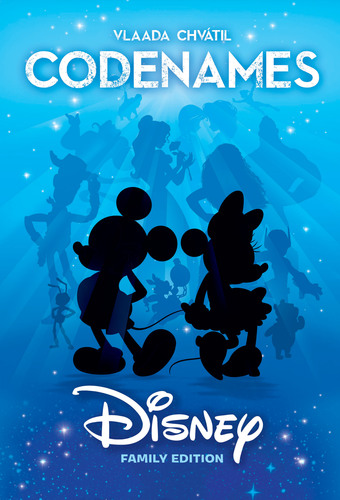
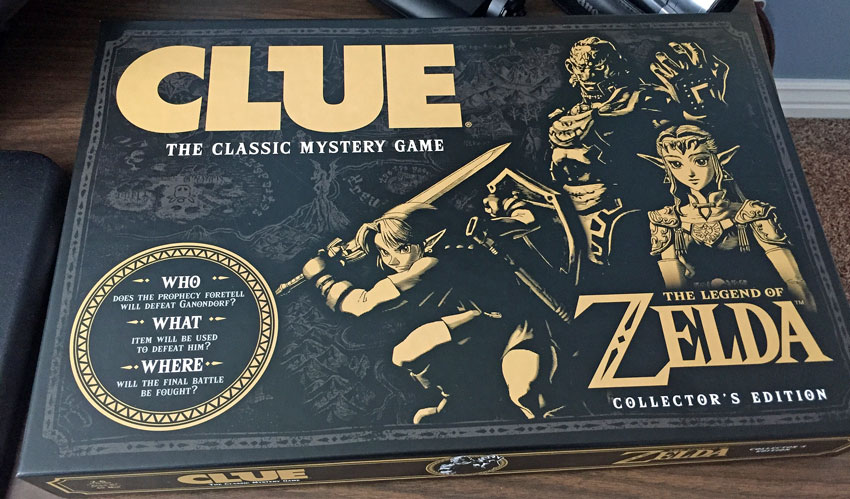
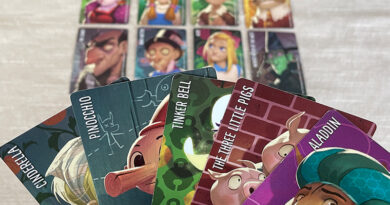
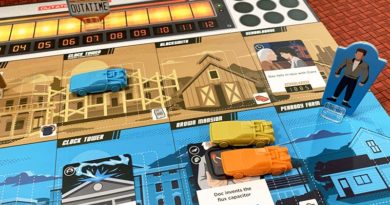
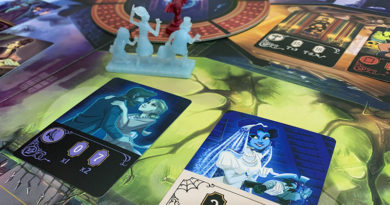
The moon tower is evil. Horrificly unbalanced. Game would be 10x more fun without it.
Donovan – It sure does wield a lot of power. The great thing is that it’s easy to just leave it out if you want and only need to get 5 Landmarks to win.
So if you already own Machi Koro and expanions, is there anything new in this edition worth adding?
Scott – If you have all the expansions, you could just play with the Bright Lights, Big City set up rules and you should be set.